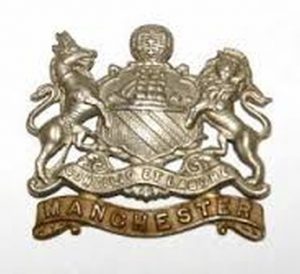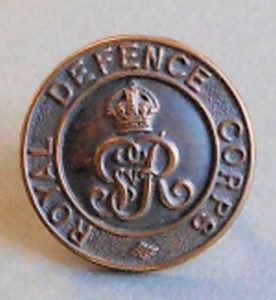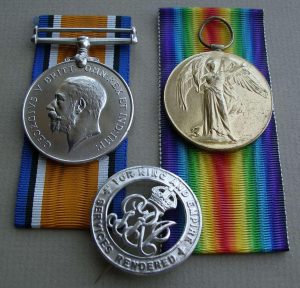Joseph Blinko [4588]
1898-1969
Father Nm: James Henry Joseph Blinko [3772] born Se Q 1862 Bermondsey mother Dakers died 1904 Rochdale D.Q.; Oldest known Ancestor – William Bates Blinko [1295] born 9.4.1789 Clerkenwell died 1856 St. Olave’s.
Mother Nm: Elizabeth Haworth [5944] 1867-1904.
Marriage Dt: 1920 to Gladys Fairburn, Rochdale, Lancashire, Volume Number: 8e, Page Number: 7
K comments: Brother William also served with the Lancashire Fusiliers.
Spouse comments:1. Gladys Fairburn. 1896 Huddersfield
Children: Joyce Blinko (Duffy) 1924-1995
(Research):GR[B] Rochdale June 1898 GR[D] Rochdale vol 10f p 975 Dec 1969.
Born 1898
Born 29.3.1898 Rochdale
1901 Census 31 Bedford St Rochdale
- James Blinks 38 Engine Driver
- Elizabeth Blinks 34
- Thomas Blinks 14
- Annie Blinks 11
- Mary Blinks 9
- Ellen Blinks 7
- Willam Blinks 5
- Joseph Blinks 3
- Martha J Blinks 1
1911 Census 31 Bedford St Rochdale Rochdale
- Blinko Annie Sister Housekeeper F 1890 Blackburn 21
- Blinko Ben Brother M 1902 Rochdale 9
- Blinko Ellen Sister Cotton Spinner F 1894 Salford, Lancashire 17
- Blinko Joseph Brother M 1898 Rochdale 13
- Blinko Mary Sister Cotton Spinner F 1892 Blackburn 19
- Blinko Thomas Head Asst Mill Engineer M 1887 Blackburn
- Blinko William Cotton Spinner M 1896 15
 |
 |
||
| Online War Photo Album |
Lancashire Fusiliers |
Manchester Regt. |
|
 |
|||
|
Royal Defence Corps. |
WW1
Blinko Joseph, 1898, Rochdale, Private,86807, 242781, 245415, 1/6th Bn. Lancashire Fusiliers, 22nd Bn. Manchester Regiment, Royal Defence Corps
1916
- 10th May. Enlisted with 6th Bn. Lancashire Fusiliers, The 1/6th Bn. was a territorial battalion and so Joseph must have volunteered for service. The 1/6th was based in Rochdale at the beginning of the war, after fighting in Gallipoli it landed in France in Feb 1917.
1917
- 3rd Aug. Joseph was sent to join the 1/6th Bn. Lancashire Fusiliers in France.
- 18th Aug. Transferred two weeks after arriving in France to the 22nd Bn. Manchester Regt. 91st Brigade of the 7th Division. Joseph was to join the 91st Brigade at Adinfer for training in readiness for battles in the Ypres area.
- 13th Sept. the 22nd Manchesters and 13th Welch sent to Etaples base to “quell a disturbance there, which they did effectively”. In reality, there were grievances built up over treatment of soldiers by NCO’s and Officers two men were tried and shot because of indiscipline. The role of the Manchesters then to bolster authority. Full story here
- 26th Sept. – 3rd Oct. Noordemhoek.(Battle of Broodeseinde)
 The 22nd Manchester’s in reserve as was its 7th Div. But on the 1st Oct. the 91st Bde. takes over the right front line on Jetty Trench.
The 22nd Manchester’s in reserve as was its 7th Div. But on the 1st Oct. the 91st Bde. takes over the right front line on Jetty Trench. - 4th Oct. Joseph wounded? The attack begins and the red line was gained by the 91st Bde. within two hours, thanks to an accurate Artillery barrage, but the Germans also gave less resistance than expected. Moving on the Blue line the 22nd Manchester’s heading towards the In der Star Cabaret came under machine-gun fire from Joiners Rest and were halted. The right flank was, however, very much exposed, as the 21st Division had failed to carry their objective. Numerous prisoners were sent down during the day.2 Oct 4th a most successful attack with over 5,000 POWs taken.1 In these operations, the battalion had the 4 Officers killed or missing and other ranks there were 45 killed, 206 wounded and 28 missing.2 It is perhaps at this point that Joseph is wounded with 206 men wounded there is much more chance that it was at this battle than the following ones where casualties were much lighter. The 4th Oct was the blackest day in 1917 for the 22nd Manchester’s the CWGC records 73 men KIA on this day.3
- 5th – 6th Oct.The line held by 91st Bde. was subjected to accurate bombardment on the 5th and 6th. The supply of food and medicine was much impeded by this and incessant rain the wounded suffered great hardships. The 91stwere relieved on the night of the 6th Oct. 2
- 24th Oct. The 91st Bde. relieved portions of the 14th and 37th Divisions astride the Menin Rd west of Gheluvelt.
- 26thOct. – 7thNov. Second Battle of Passchendaele. The target Gheluvelt, the attack entrusted to the 91st Bde. and the 20th Bde. Mud and terrible conditions combined more than anything to check the attack and prevent the capture of Gheluvelt. It may have been in this battle or the battle of Broodseinde that Joseph was wounded.
- 7th Nov. Joseph transferred to the Royal Defence Corps to take part in home defence activities. Joseph was returned back to England likely well before this date.
Sources
- The Seventh Division. Atkinson, C.T. Luton: Andrews UK:2012
- Battle of Broodseinde Ridge
- CWGC database of casualties
Medals
The Medal Index Card shows that Joseph served overseas and that the Medal roll number TP/102B11 is associated with the Royal Defence Force. As Joseph was serving with RDC at war’s end it was their responsibility to provide the Medal lists for all within their control, and this meant discovering where they were serving when they first entered a war zone. The RDC Medal Roll TP/102B11 Page1272 details for Joseph show that while he was on the RDC Roll he was awarded his medal for a short but bloody period overseas with the 6th Bn. Lancashire Fusiliers and the 22nd Bn. Manchester Regiment between Aug 1917 and Nov 1917
 Awarded the British and Victory medals plus the Silver War Badge.
Awarded the British and Victory medals plus the Silver War Badge.
After the War
Death 1969 age 71 years
Rochdale, Lancashire, Volume: 10f Page 975.
Gallery
There are 3 records in the National Archives for this man. For copyright reasons they cannot be re-published.

Photo shows Lancashire Fusiliers marching through Rochdale off to join the War
Extract from http://www.lancs-fusiliers.co.uk/
“The Middleton territorials were called to the Drill Hall, on Rochdale Road (opposite where the BP garage now stands), on the day war broke out on August 4 and duly marched to Rochdale to join up with the other men who were to fight alongside them as part of the 1/6th Lancashire Fusiliers – 500 Rochdale territorials and 250 from Todmorden.
These men were a near-perfect cross section of local society. The officers were from wealthy families and the men came from all walks of life – from white collar roles with the local council to labouring jobs in the mills. Private Briggs, for example, was a Middleton mill hand while his commander was Major Lees, who was a wealthy landowner living in Alkrington Hall.
All of these men put their normal lives on hold to train daily for combat.”

John Cockayne. 22 March 1917. He was in the 24 Manchester Regiment

Entitled ‘going to the trenches’ dated 1915
7th division


The map shows the targets for the Allied forces including the 22nd Bn. who were near Polygon Wood and tasked to advance past the wood and capture Broodseinde ridge.


Extract from http://themanchesters.org
“The 22nd Manchesters, in conjunction with the 1st South Staffords advanced to the attack at 6am. One company of 21st Manchesters were in support as moppers-up. The South Staffords easily carried their objective the Red Line. The Manchesters took to Blue Line, or second objective and gained touch with the 2nd Border Regiment. The right flank was, however, very much exposed, as the 21st Division had failed to carry their objective. Numerous prisoners were sent down during the day. At 10.25am one company of the 21st Manchesters was sent up to reinforce, and at 3.15pm a further company, as the front line was distinctly weak. At dusk, the enemy was reported to be massing for a counter-attack, but this attempt failed to materialise owing to the effectiveness of the British artillery fire. Yet the conditions were precarious and suspense was in the air. And, during the night, rations and water were brought up with great difficulty. Meanwhile, officers in the front line reorganised their resources and consolidated in depth. There was heavy shelling at dawn on the 5th but otherwise the day passed without event. On the 6th The Butte, Jolting Trench and Jettz Trench were heavily shelled and a good deal of MG fire and sniping was experienced from Judge Copse. But the long ordeal came to an end when at 3am on the 7th, the 9th Devons relieved. The battalion proceeded to bivouacs west of Zillebeke, and later to camp at Dickebusch. The weather was very wet”.
In these operations the battalion had the 4 Officers killed or missing and other ranks there were 45 killed, 206 wounded and 28 missing.”

German blockhouse or pillbox on Broodseinde Ridge, 17 October 1917. [AWM E01034]


